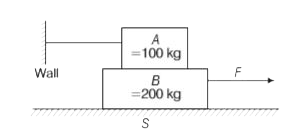A is a 100kg block, and B is a 200kg block. As shown in figure the block A is attached to a string tied to a wall. The coefficient of friction between A and B is 0.2 and the coefficient of fricition between B and floor is 0.3. Then calculate the minimum force required to move the block B.
(take g=10m/s2).

When B is tied to move, by applying a force F, the frictional forces acting on the block B are f1andf2 with limiting values, f1=(μs)AmAgandf2=(μs)B(mA+mB)g the minimum vlaue of F should be (for just tending to move),
F=f1+f2=0.2×100g+0.3×300g=110g=1100N
Topper's Solved these Questions
- NEWTON'S LAWS OF MOTION & FRICTIONBook:ALLENChapter:NEWTON'S LAWS OF MOTION & FRICTIONExercise:EXERCISE (S-1)
Explore 26 Videos
- NEWTON'S LAWS OF MOTION & FRICTIONBook:ALLENChapter:NEWTON'S LAWS OF MOTION & FRICTIONExercise:EXERCISE (S-2)
Explore 9 Videos
- MOTION IN A PALNEBook:ALLENChapter:MOTION IN A PALNEExercise:SOLVED EXAMPLE
Explore 28 Videos
- NEWTONS LAWS OF MOTIONBook:ALLENChapter:NEWTONS LAWS OF MOTIONExercise:EXERCISE-III
Explore 28 Videos
Similar Questions

Block A weighing 100 kg rests on a block B and is tied with a horizontal string to the wall at C. Block B weighs 200 kg. The coefficient of friction between A and B is 0.25 and between B and the surface is 1/3. The horizontal force P necessary to move the block B should be (g=10m/s2)
View SolutionA block A of mass 200kg rest on a block B of mass 300kg. A is tied with a horizontal string to a wall. Coefficient of friction between A and Bis0.25 and that between B and floor is 0.2. The horizontal force F needed to move the block B is

View Solution
Knowledge Check
Two blocks A and B having masses 100 kg and 200 kg are placed as shown in the figure. The block A is connected to a wall with a light inextensible string. The coefficient of friction between the blocks is 0.3 and that between the block B and the floor is 0.03. Then the minimum force required to move the block B will be (take g=10m/s2)
 A600 NB800 NC900 ND1100 N
A600 NB800 NC900 ND1100 NA block A of mass 100 kg rests on another block B of mass 200 kg and is tied to a wall as shown in the figure. The coefficient of friction between A and B is 0.2 and that between B and ground is 0.3. The minimum force required to move the block B is (g=10ms−2)
 A900 NB200 NC1100 ND700 N
A900 NB200 NC1100 ND700 NA block A with mass 100kg is resting on another block B of mass 200kg. As shown in figure a horizontal rope tied to a wall hold it. The coefficient of friction between A and B is 0.2 while coefficient of friction between B and the ground is 0.3 . the minimum required force F to start moving B will be.
 A900NB100NC1100ND1200N
A900NB100NC1100ND1200N
A block A of mass 100 kg rests on another block B of mass 200 kg and is tied to a wall as shown in the figure. The coefficient of friction between A and B 0.3. The minimum force F required to move the block B is (g=10−2

View SolutionA block A of mass 100 kg rests on another block B of mass 200 kg and is tied to a wall as shown in the figure. The coefficient of friction between A and B 0.3. The minimum force F required to move the block B is (g=10−2

View SolutionA block of mass 2 kg is kept on a rough horizontal floor an pulled with a force F. If the coefficient of friction is 0.5. then the minimum force required to move the block is :-

View SolutionA block A of mass 2 kg rests on another block B of mass 8 kg which rests on a horizontal floor. The coefficient of friction between A and B is 0.2 while that between B and floor is 0.5. when a horizontal force of 25 N is applied on the block B. the force of friction between A and B is
View SolutionA block A of mass 2kg rests on another block B of mass 8kg which rests on a horizontal floor. The coefficient of friction between A and B is 0.2 while that between B and floor is 0.5.When a horizontal floor F of 25N is applied on the block B the force of friction between A and B is
View Solution